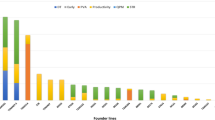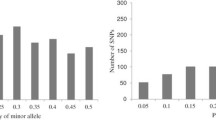Abstract
Characterization of genetic diversity among maize inbred lines can facilitate organization of germplasm and improve efficiency of breeding programs. A set of 218 phenotypically diverse inbred maize lines developed at CIMMYT for hybrid production was characterized using 32 RFLP markers to: (1) analyze the genetic diversity present; (2) define potential heterotic groups based on clusters formed with marker data; and (3) identify the most representative testers for each potential heterotic group. Lines were clustered using five different genetic distance measurements to find consensus non-hierarchical clusters. Dendrograms were produced to study hierarchical classification within smaller groups of lines. A very high average allelic diversity was seen in this germplasm. Lines did not cluster based on phenotype, environmental adaptation, grain color or type, maturity, or heterotic response (as determined based on hybrid performance with testers), but lines related by pedigree usually did cluster together. Previously defined testers from opposite heterotic groups were not genetically differentiated, and did not represent well their heterotic group. Discrete clusters were difficult to find; thus, potential heterotic groups will be difficult to suggest using RFLP markers alone. However, suggestions on how to use molecular markers and cross performance information to refine heterotic groups and select representative testers are presented.
Similar content being viewed by others
References
Cavalli-Sforza, L.L. & A.W. Edwards, 1967. Phylogenetic analysis: Models and estimation procedures. Evolution 32: 550–570.
CIMMYT, 2001. The Applied Biotechnology Center’s Manual of Laboratory Protocols, 1st edn., Mexico DF.
Darrah, L.L. & M.S. Zuber, 1985. United States farm maize germplasm base and commercial breeding strategies. Crop Sci 26: 1109–1113.
Dillman, C., A. Bar-Hen, D. Guerin, A. Charcosset & A. Murigneux, 1997. Comparison of RFLP and morphological distances between maize Zea mays L. inbred lines: Consequences for germplasm protection purposes. Theor Appl Genet 95: 92–102.
Dubreuil, P., P. Dufour, E. Krejci, M. Causse, D. de Vienne, A. Gallais & A. Charcosset, 1996. Organization of RFLP diversity among inbred lines for maize representing the most significant heterotic groups. Crop Sci 36: 790–799.
Edmeades, G.O., J. Bolaños & H.R. Lafitte, 1992. Progress in breeding for drought tolerance in maize. In: D. Wilkinson (Ed.), Proceedings of the 47th Annual Corn and Sorghum Ind. Research Conference 1992, pp. 93–111. ASTA, Washington.
Everitt, S. & G. Dunn, 1992. Applied Multivariate Data Analysis. Oxford University Press.
Excoffier, L., P. Smouse & J. Quattro, 1992. Analysis of molecular variance inferred from metric distances among DNA haplotypes: Application to human mitochondrial DNA restriction data. Genetics 131: 479–491.
Goodman, M.M., 1999. Broadening the genetic diversity in maize breeding by use of exotic germplasm. In: J.G. Coors & S. Pandey (Eds.), The Genetics and Exploitation of Heterosis in Crops. ASA, Wisconsin, USA.
Hallauer, A.R., W.A. Russell & K.R. Lamkey, 1988. Corn breeding. In: G.F. Sprague & J.W. Dudley (Eds.), Corn and corn improvement, 3rd edn. Agron Monogr 18, ASA, CSSA and SSSA, Madison, Wisconsin, pp. 463.
Kaufman, L. & P.J. Rousseeuw, 1990. Finding Groups in Data. John Wiley & Sons, New York.
Livini, C., P. Ajmone-Marsan, A.E. Melchinger, M.M. Messmer & M. Motto, 1992. Genetic diversity of maize inbred lines within and among heterotic groups revealed by RFLP’s. Theor Appl Genet 84: 17–25.
Lu, H. & R. Bernardo, 2001. Molecular marker diversity among current and historical maize inbreds. Theor Appl Genet 103: 613–617.
Mantel, N.A., 1967. The detection of disease clustering and a generalized regression approach. Cancer Res 27: 209–220.
Melchinger, A.E., 1997. Genetic Diversity and Heterosis. Book of Abstracts. The Genetics and Exploitation of Heterosis in Crops: An International Symposium. Mexico, DF, Mexico, p. 54.
Messmer, M.M., A.E. Melchinger, J. Boppenmaier, E. Brunklaus-Jung & R.G. Herrmann, 1992. Relationships among early European maize inbreds. I. Genetic diversity among flint and dent lines revealed by RFLPs. Crop Sci 32: 1301–1309.
Messmer, M.M., A.E. Melchinger, G. Reinhold, R.G. Herrmann & J. Boppenmaier, 1993. Relationships among early European maize inbreds. II. Comparison of pedigree and RFLP data. Crop Sci 33: 944–950.
Milligan, G.W., S.C. Soon & L. Sokol, 1983. The Effect of Cluster Size, Dimensionality, and the Number of Clusters on Recovery of True Cluster Structure. IEEE Transactions on Pattern Analysis and Machine Intelligence, Vol. PAMI-5, No. 1.
Mojena, R., 1977. Hierarchical grouping methods and stopping rules: An evaluation. Computer J 20: 359–363.
Nei, M., 1972. Genetics distance between populations. Am Naturalist 106: 283–292.
Nei, M., 1973. Analysis of gene diversity in subdivided populations. Proc Natl Acad Sci USA 70: 3321–3323.
Pandy, S. & C.O. Gardner, 1992. Recurrent selection for population, variety, and hybrid improvement in tropical maize. Adv Agron 48: 1–87.
Reif, J.C., A.E. Melchinger, X.C. Xia, M.L. Warburton, D.A. Hoisington, S.K. Vasal, G. Srinivasan & M. Frisch, 2003a. Genetic distance based on simple sequence repeats and heterosis in tropical maize populations. Crop Sci 43: 1275–1282.
Reif, J.C., A.E. Melchinger, X.C. Xia, M.L. Warburton, D.A. Hoisington, S.K. Vasal, D. Beck, M. Bohn & M. Frisch, 2003b. Use of SSRs for establishing heterotic groups in subtropical maize. Theor Appl Genet 107: 947–957.
Rogers, J.S., 1972. Measures of Genetic Similarity and Genetic Distance. Studies in Genetics VII. University of Texas, Publication no. 7213, pp. 145–153.
Smith, J.S.C., D.N. Duvick, O.S. Smith, A. Grunst & S.J. Wall, 1999. Effect of hybrid breeding on genetic diversity in maize. In: J.G. Coors & S. Pandey (Eds.), The Genetics and Exploitation of Heterosis in Crops, pp. 119–126. ASA, Wisconsin, USA.
Smith, J.S.C., 1997. Effect of Hybrid Breeding on Genetic Diversity in Maize. Book of Abstracts. The Genetics and Exploitation of Heterosis in Crops: An International Symposium. Mexico, DF, Mexico, p. 55.
Smith, J.S.C., O.S. Smith, S. Wright, S.J. Wall & M. Walton, 1992. Diversity of U.S. hybrid maize germplasm as revealed by restriction fragment length polymorphisms. Crop Sci 32: 598–604.
Schneider, S., D. Roessli & L. Excoffier, 2000. Arlequin ver. 2000: A Software for Population Genetics Data Analysis. Genetics and Biometry Laboratory, University of Geneva, Switzerland.
Troyer, A.F., 1999. Background of U.S. hybrid corn. Crop Sci 39: 601–626.
Vasal, S.K., B.S. Dhillon & S. Pandey, 1997. Recurrent selection methods based on evaluation-cum-recombination block. Plant Breeding Rev 14: 139–163.
Vasal, S.K., G. Srinivasan, D.L. Beck, J. Crossa, S. Pandey & C. De Leon, 1992. Heterosis and combining ability of CIMMYT’s tropical late white maize germplasm. Maydica 37: 217–223.
Warburton, M.L., X. Xianchun, J. Crossa, J. Franco, A.E. Melchinger, M. Frisch, M. Bohn & D. Hoisington, 2002. Genetic characterization of CIMMYT inbred maize lines and open pollinated populations using large scale fingerprinting methods. Crop Sci 42: 1832–1840.
Weir, B.S. & C.C. Cockerham, 1984. Estimating F-statistics for the analysis of population structure. Evolution 38: 1358–-1370.
Wellhausen, E.J., 1978. Recent developments in maize breeding in the tropics. In: D.B. Walden (Ed.), Maize Breeding and Genetics. John Wiley & Sons, New York, pp. 59–84.
Wright, S., 1978. Evolution and the Genetics of Populations, Vol. 4. Variability Within and Among Natural Populations. University of Chicago Press, Chicago.
Xia, X.C., J.C. Reif, D.A. Hoisington, A.E. Melchinger, M. Frisch & M.L. Warburton, 2004. Genetic diversity among CIMMYT maize inbred lines investigated with SSR markers. I. Lowland tropical maize. Crop Sci 44: 2230–2237.
Yap, I. & R.J. Nelson, 1996. WinBoot: A Program for Performing Bootstrap Analysis of Binary Data to Determine the Confidence Limits of UPGMA-Based Dendrograms. IRRI. Discussion Paper Series No. 14. International Rice Research Institute, P.O. Box 933, Manila, Philippines.
Yuan, L.X., J.H. Fu, M. Warburton, X.H. Li, S.H. Zhang, M. Khairallah, X. Liu, Z. Peng & L. Li, 2000. Comparison of genetic diversity among maize inbred lines based on RFLPs, SSRs, AFLPs and RAPDs. Acta Genet Sin 27: 725–733.
Author information
Authors and Affiliations
Corresponding author
Rights and permissions
About this article
Cite this article
Warburton, M.L., Ribaut, J.M., Franco, J. et al. Genetic characterization of 218 elite CIMMYT maize inbred lines using RFLP markers. Euphytica 142, 97–106 (2005). https://doi.org/10.1007/s10681-005-0817-y
Received:
Accepted:
Issue Date:
DOI: https://doi.org/10.1007/s10681-005-0817-y




